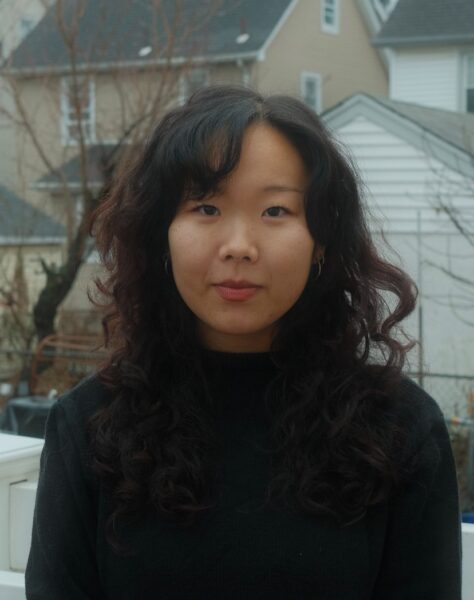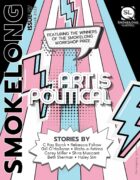The imagery of the haenyeo (the “barnacled women”) in the first passage is so compelling—have you visited Jeju Island? What inspired you to use the haenyeo as an extended metaphor throughout the piece?
I’ve never been to Korea at all, let alone Jeju, despite many plans and thoughts of visiting! My knowledge of haenyeos has come from books, documentaries, and whatever Korean television programs my grandmother had on growing up.
There is so much that is fascinating and beautiful about the haenyeo lifestyle. Because it is a bit of a dying tradition, most of them are well into their sixties, seventies, and beyond, having trained when they were young girls and women. They continue to dive into hostile temperatures and pressure because the water is an inseparable part of their lives. The sea is precious and beloved to haenyeos, and they are devoted to its health and ethical harvest.
I’ve admired and respected them for as long as I’ve known who they were, and there have probably been dozens of iterations of the first lines of this flash fiction piece that I had been trying to get right and ready for a while, now.
I do predict I’ll find myself in Jeju one day, crying stupid about the sea and mountains and all.
I noticed the overlap between the matriarchal structure of the haenyeo, who pass down their diving practices from generation to generation, and how the narrator’s mother passes down her practice of “[conducting] anger” to the narrator: generational trauma paired with generational vocation. Can you speak to how these passages came together?
It’s apt that you use the term “generational vocation” because punching is also sort of a family business to me. My mother and I both grew up in my grandfather’s Astoria taekwondo studio, so although not purely matrilineal, punching and kicking was indeed passed down to us from the previous generation, albeit in a more controlled and methodical environment than in the flash piece.
The two passages were both written separately, and for a while they were just respective sections of lines and chunks that I couldn’t figure out how to make complete. It wasn’t until I left them both alone for a while, and when reading through pages of my notebooks and junk journals that I realized how complementary they were to each other, and everything became a whole.
It happens like that a lot for me because there are always very specific themes and ideas I’m consciously or subconsciously attracted to writing about that inevitably converge. I just need to take a step back sometimes to see what fits where.
The use of “clubbed thumbs” as a metaphor here is so distinct. It is yet another clear image of inherited, generational pain. As you wrote this piece, what did this metaphor signify to you?
When I was writing, I actually didn’t have this in mind as a metaphor—that imagery began very literally and tangibly to me because my own mother and I have clubbed thumbs, ha ha. They have always felt like a distinct feature that my mother and I share, and so in pursuit of portraying Mother and Daughter here, I think I kind of went … well, what says Matrilineage like jank-ass thumbs?
And my mother is the one who taught me proper punching form: to keep my thumbs outside my fist. Pretty stoked to report I’ve snapped no bones.
The ending lines of this piece are so striking, especially since they stand apart from the rest of the passages. Particularly, I love how the final line brings us back to the imagery of the haenyeo: “breathe underwater” becomes “breathe under this roof.” Can you walk us through your thoughts on the final lines?
I believe the original line I’d written for the mother was “This is how to live under this roof,” but once I knew that these two passages were coming together—the haenyeos with the mother and daughter—I loved the symmetry of repeating “breathe under.” The similar themes were unifying enough on their own, but that repetition made a secure join that I needed on a tangible level.
What has been inspiring to your writing practice recently?
I keep a couple of small notebooks and journals where I’ll write lines or ideas that I’m excited about, but aren’t fully formed yet. I’ll leave them alone for a while, and then some time later, I’ll go through the bullets and scribble and see what’s marinated a little bit, what I can add or combine—like I did for ‘haenyeo.’ So, reading through those old thoughts and notions with a fresh mind is good food for writing.
I went on a trip out west this past fall in order to gain new landscapes and some of that mind-freshness, and the farther I went, the more I wanted to write about home and the things close and familiar to me. I think that’s how it goes, distance and hearts and fondness.
No matter how difficult it is for me to step away from an exciting idea, it’s usually the case that some time and space makes better writing happen for me. My mother taught me patience, too. Punching and patience.



 The core workshop of SmokeLong Fitness is all in writing, so you can take part from anywhere at anytime. We are excited about creating a supportive, consistent and structured environment for flash writers to work on their craft in a community. We are thrilled and proud to say that our workshop participants have won, placed, or been listed in every major flash competition. Community works.
The core workshop of SmokeLong Fitness is all in writing, so you can take part from anywhere at anytime. We are excited about creating a supportive, consistent and structured environment for flash writers to work on their craft in a community. We are thrilled and proud to say that our workshop participants have won, placed, or been listed in every major flash competition. Community works.